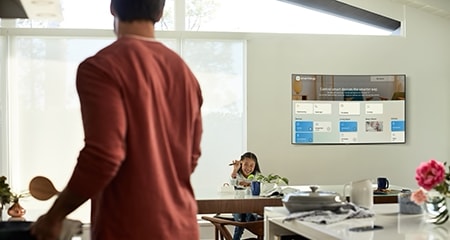A guide to finding the right size Samsung TV for your room

Choosing the right TV size for your room depends on important factors such as your budget and the size of the room. While your budget may be the deciding factor, the size of your TV also depends on how far you want to sit from the screen and how immersive you want your viewing experience to be.
Note: The provided information refers to Samsung Smart TVs sold in Canada. The available settings and options may differ for devices sold in other countries.
Today's UHD TVs offer more detail than previous models, so you can sit closer than before. However, sitting too close may still cause eye strain. While it all boils down to personal preference, there is a simple formula that can help provide a good starting point:
Viewing distance (in inches)/2 = recommended TV size

For example, if you usually sit 10 feet (10 m) from the TV, that's 120 inches (10 x 12 inches).
Viewing distance = 120/2 = 60
The screen size for you is 60 inches (and remember, that's the diagonal measurement of the screen).
It's the night of the big game; you've just loaded your plate with nachos and wings, and then it happens. You walk into the living room to find someone sitting in "your spot." When there are fewer places to sit in front of the TV than people in the room, it can be a real downer.

Here are some suggestions for making sure everyone has a good view, even in crowded rooms:
- For crowded rooms, you should go with at least a 40-inch screen if you are seated more than six feet from the TV.
- A 50-inch screen is good within 7.5 feet of the TV.
- If you are 9 feet away, a 60-inch screen is probably as small as you want to go.
- Keep in mind the ideal distance can vary depending if you mount your TV on a wall or place it on a stand. Mounting a TV on the wall can give you a little more room to work with.
Viewing angles are also important when you're buying an HDTV for a living room. One suggestion is that the TV be placed parallel to your eyes, with no more than a 15-degree angle up or down, and no more than a 40-degree angle to the left or right.

If you are seated at a sharp angle to the TV, the picture may look distorted, unless you have a UHD/4K TV.
The larger a UHD TV screen, the more important screen resolution becomes.
For a UHD TV that is 40 inches or smaller, a 720p resolution is usually good. However, if you have a 50-inch screen or larger, you will probably need a higher resolution, like 1080p.
1080p resolution (Full HD) has 1920 by 1080 pixels, which offers great picture quality. Full HD really shines on video game consoles, Blu-ray discs, and HD cable or satellite channels. But 4K resolution takes it one step up with even higher resolution for a clearer, sharper picture: 3840 by 2160 pixels.

But if you're looking for our best picture quality 8K UHD is where you'll find it. Samsung 8K TVs have 16x the number of pixels as our Full HD TVs. They also have amazing upscaling capability, which means they can take a lower quality image and raise the quality up to 8K resolution (7680 by 4320 pixels).
Note: 8K AI Upscaling enhances content to near-8K picture quality, based on laboratory testing. Viewing experience may vary according to types of content and format. 8K AI Upscaling may not apply to PC connection, and certain conditions of Game Mode.
Is this content helpful?
Thank you for your feedback!
Please answer all questions.
